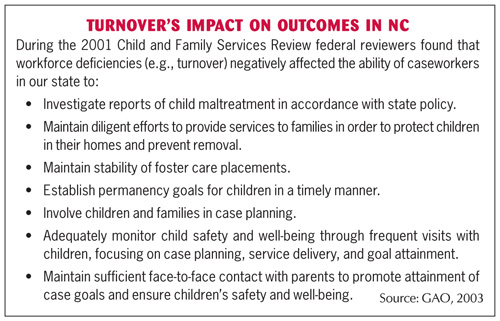 |
 |
 |
©
2007 Jordan Institute
for Families

Vol.
12, No. 1
January 2007
The Educational Needs of Kids in Foster Care
Much of what we know about the current status of child welfare worker retention in North Carolina comes from the NC Association of County Directors of Social Services. Gunderson and Osborne (2001) shared county data and responses to a statewide survey that are particularly telling.
Turnover Rates. Fifty-nine of North Carolina’s 100 counties (including all but one of the major metropolitan counties) responded to a survey and reported that the average turnover rate was 44% among CPS workers. (Note: a 2004 study by the NC Office of State Personnel Study found an average statewide child welfare vacancy rate of 31%.)
Readiness of New Hires. Directors also reported that 54% of the workers they hired were more than two years short of the experience needed to meet minimum job requirements. Counties estimated that it took 2-3 months to fill a vacancy and another 4-5 months before a newly-hired worker was ready to manage a full caseload. Yet, directly after new hires attend the state-mandated 72 hours of preservice training, they are often given a full caseload because of agency vacancies and caseload demands.
Reasons to Stay. The Directors’ Association also surveyed 170 social workers about issues of retention and high turnover rates. They identified the following as the most important retention aspects of their jobs: (1) work/family balance; (2) pride in their work; (3) salary; and (4) employee-focused management.
Reasons to Leave. In the same survey, workers said the reasons they would leave were: (1) low salary; (2) stress; (3) overwork; (4) bureaucratic, non-supportive nature of their agency; and (5) lack of advancement or educational opportunities.
